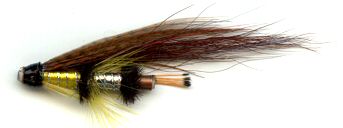The Yellow Torrish 1 Inch Copper Tube Fly
The Yellow Torrish is an excellent spring Salmon and Steelhead fly. It is one of the old flies that grew popular all over the world due to the established fishing tackle company Hardy Brothers, selling them throughout the British Empire and beyond.

SALTWATER, SALMON & STEELHEAD TUBE FLY
$US each. Price does not include hooks.
The Yellow Torrish received its name from a small town called Torrish in the Scottish North West Highlands. It was designed in the mid 19th century, to fish the river Helmsdale which runs through the area and near the town. This fly, that is over 150 years old, still catches great Salmon. The color and tinsel of this fly make it very attractive. Look at young trout and other baitfish. You will notice that their underneath is of a pale yellow to olive green color mixed with silver scales and a darker back. This is what the Yellow Torrish tries to suggest to the bigger hungry fish. Because of it's brightness it is particularly useful when the water is rising darkly, just before the earthy stain arrives, and when the stream is settling after a spate.
RIVER TWEED SALMON FISHING WITH A TUBE FLY
Too many trout and new salmon fly fishermen believe that catching salmon is a chuck-it-in-and-see-what-happens affair and catching fish is down to luck. Did this happen because of an overheard greeting, "Any Luck?" between two salmon anglers? Was this how the rumour started? The man that catches salmon must be ‘lucky’ compared with the fisherman who fails to find fish even in the same location at the same time of the day. Down the pub he is considered ‘unlucky’. What a load of bull shit. It is skill, knowledge and practice that catches salmon not luck.
The primary qualification of those salmon fishermen who consistently make their own ‘luck’ is that they pay attention to detail. They keep their hooks sharp. If they lose a salmon due to a break in the leader at a wind-knot, they tell themselves off, first for having allowed it to be there and second for not spotting it. They choose good tackle of the correct weight and practise with it to be able to make the most of each and every fish taking opportunity they spot. Get the basics right and success will follow.
Before you even get to the water study previous year’s fishing reports on the internet or in the fishing lodge. Ask the locals for their advice. Spend your leisure time reading books and magazine articles on salmon fishing. Use your eyes and study the river before you send out your first cast. Work out where the most likely places the salmon can be found. Know what to do in different weather and water conditions at different times of the year. That way you can make good educated decisions about what tactics to use.
In early autumn on the river Tweed in Scotland the water temperature and cold wind made me decide to fish with a sinking line and a heavy large fly. I knew the salmon will be seeking protection from the elements in the depths. As it was cold they would not be actively rising for food. They would conserve energy by waiting for potential food to swim past them at eye level. I tied on a Yellow Torrish 1 Inch copper tube fly. The long wing naturally moved like a swimming bait fish and the copper body meant that the fly got down to the correct level fast. It was what those salmon in the taken mood seemed most ready to fall for.
I created my own ‘luck’ by using observation to work out where the fish where. I used the correct choice of line and fly to fish at the depth they were resting at. If I had used a surface salmon bomber fly or a single hook salmon fly on a floating line in those cold conditions I would have had a day of fishing in beautiful countryside but without any fish to show for my labours.

